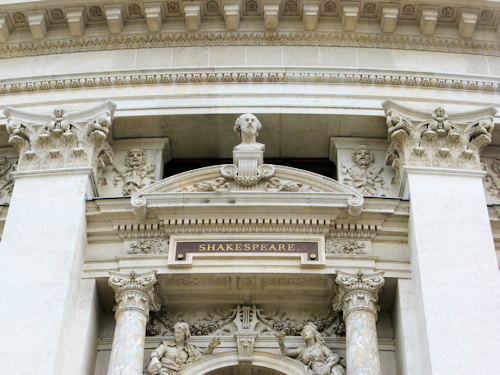
Consider the Burgtheater or simply “The Burg” as essentially Austria’s national theatre. And the main building forms one of the many historical landmarks that grace the Ring boulevard that curls its way around Vienna’s centre.
- The pinnacle of Austrian theatre, but all plays are in German
- “Subtitles” accessible for some performances
- Tours of the 19th-century building available
- Gustav Klimt worked on the interior décor as a young man
- Book a themed guided tour* of the city
- See also:
The national theatre

(View from the Rathausplatz square opposite. What you can’t see is the 300m2 solar panel facility on the roof)
This version of the Burgtheater opened in 1888, but the institution itself has a long history involving emperors, wars, and even fan fiction rewrites.
Today, an in-house ensemble puts on regular performances of plays penned by promising contemporary playwrights through to the great names of world theatre: Shakespeare, Schiller (who has his own Viennese monument) and Goethe (ditto), for example.
To be part of that ensemble in whatever form is a badge of honour you might compare to being a member of the RSC in the UK. And, although a purely German-speaking theatre, even English-speaking audiences might recognise some of the actors who belong (or belonged) to the Burgtheater’s company.
For example:
- Klaus Maria-Brandauer gained an Oscar nomination for his role in Out of Africa opposite Meryl Streep in 1985
- Oskar Werner starred opposite Julie Christie in Truffaut’s Fahrenheit 451 in 1966
- Felix Kammerer played the lead in the 2022 Oscar-winning film, All Quiet on the Western Front

(The homage to Shakespeare)
Walk around the outside of the theatre to find numerous tributes to famous playwrights and poets. Shakespeare himself gets a bust and as representation of the to be or not to be scene from Hamlet.
Inside, one of the opulent staircases has another Shakespeare tribute: a fresco of a performance of Romeo and Juliet at the Globe Theatre, London.
The three artists responsible for creating that ceiling fresco cheekily put themselves into the Globe’s audience. Which is why you find a young Gustav Klimt in the painting. His subsequent career went quite well to say the least.
Tickets and tours
If you just want to take a look inside the Burgtheater and view the Klimt frescoes, then go on a guided tour.
If you want to view a play, do remember that performances are in the German language. However, some of these performances have English “subtitles” available through a free app for your phone.
For the record, tickets usually go on sale as of the 20th of each month for the following month; no performances take place during a summer break.
The Burgtheater, despite its origins as the official national and imperial theater of the Habsburg Empire, has an egalitarian tradition that continues today.
Seats with unrestricted views can cost as little as a typical cinema ticket. You can even see a performance for just €4 when standing tickets are available.
How to get to the Burgtheater
You’ll find this ca. 1,200-seat theater on Vienna’s Ring, opposite the Rathausplatz. A near neighbour is the Volksgarten park, specifically the rose garden section that looks gorgeous in early summer.
If you fancy a quick coffee and cake before a performance (or tour), the Burgtheater’s other immediate neighbour belongs to that long list of traditional institutions that makes Vienna (possibly) the coffee house capital of the world.
Subway: the Burgtheater is just a short walk from three subway stations: Rathaus on the U2 line, Schottentor (also on the U2), and Herrengasse on the U3 line.
Tram/bus: three tram lines serve a tram stop right outside the front door: 1, 71 and D. Get off at Rathausplatz/Burgtheater (the clue is in the name).
Address: Dr. Karl-Lueger-Ring 2, 1010 Vienna | Website